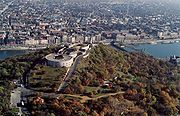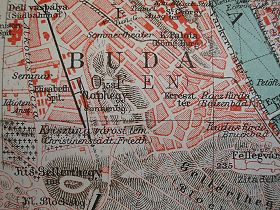
Gellért Hill
Encyclopedia


Danube
The Danube is a river in the Central Europe and the Europe's second longest river after the Volga. It is classified as an international waterway....
in Budapest
Budapest
Budapest is the capital of Hungary. As the largest city of Hungary, it is the country's principal political, cultural, commercial, industrial, and transportation centre. In 2011, Budapest had 1,733,685 inhabitants, down from its 1989 peak of 2,113,645 due to suburbanization. The Budapest Commuter...
, Hungary
Hungary
Hungary , officially the Republic of Hungary , is a landlocked country in Central Europe. It is situated in the Carpathian Basin and is bordered by Slovakia to the north, Ukraine and Romania to the east, Serbia and Croatia to the south, Slovenia to the southwest and Austria to the west. The...
. It is part of the 1st and 11th Districts. Gellért Hill was named after Saint Gerard
Gerard Sagredo
Saint Gerard Sagredo , also called Gerhard or Gellert, was an Italian bishop from Venice who operated in the Kingdom of Hungary , and educated Saint Emeric of Hungary, the son of Saint Stephen of Hungary). He played a major role in converting Hungary to Christianity...
who was thrown to death from the hill. The famous Hotel Gellért
Hotel Gellért
Hotel Gellért is a famous, first class four star hotel in Budapest, Hungary. The hotel was erected on the right bank of the river Danube between 1916 and 1918 in the Art Nouveau style with some biomorphic elements, at the foot of Gellért Hill, next to Szabadság Bridge.The four star Danubius Hotel...
and the Gellért Baths
Gellért Baths
Gellért Thermal Baths and Swimming Pool, also called Gellért fürdő or Gellért Baths, are a bath complex in Budapest, Hungary, built between 1912 and 1918 in the Art Nouveau style. They were damaged during World War II, but then rebuilt. References to healing waters in this location are found from...
can be found in Gellért Square at the foot of the hill, next to Liberty Bridge
Liberty Bridge (Budapest)
The Szabadság híd or Liberty Bridge in Budapest, Hungary, connects Buda and Pest across the River Danube. It is the third southernmost public road bridge in Budapest, located at the southern end of the City Centre....
. The Gellért Hill Cave
Gellért Hill Cave
The Gellért Hill Cave is part of a network of caves within Gellért Hill in Budapest, Hungary. The cave is also referred to as "Saint Ivan's Cave" , regarding a hermit who lived there and is believed to have used the natural thermal water of a muddy lake next to the cave to heal the sick...
is located within the hill, facing toward Hotel Gellért and the Danube
Danube
The Danube is a river in the Central Europe and the Europe's second longest river after the Volga. It is classified as an international waterway....
River.
At the top of the hill is the Citadella
Citadella
Citadella is the Hungarian word for Citadel, a kind of fortress. The word Citadella is exclusively used by other languages to address the Citadel located upon the top of the strategic Gellért Hill in Budapest, Hungary.-History:...
(Citadel), from which a view is available down both directions of the Danube.
Name
The first recorded names of the hill in the Middle Ages were Kelen-hegy, Pesti-hegy and Blocksberg. It was called Szent Gellért hegye (lit. the hill of St. Gerard) from the 15th century onwards, referring to the legend about the death of St. Gerard. The saintly bishop was killed by the pagans during the great pagan rebellion in 1046. He was put in a barrel and rolled down into the deep from the top of the hill.The former name, Pesti-hegy referred the large cave (now Gellért Hill Cave
Gellért Hill Cave
The Gellért Hill Cave is part of a network of caves within Gellért Hill in Budapest, Hungary. The cave is also referred to as "Saint Ivan's Cave" , regarding a hermit who lived there and is believed to have used the natural thermal water of a muddy lake next to the cave to heal the sick...
) in the hillside. The word is of Slavic origin and means oven or cave.
The Ottoman Turks called the hill Gürz Elyas bayiri. Gürz Elyas was a holy man from the Bektashi
Bektashi
Bektashi Order or Bektashism is an Islamic Sufi order founded in the 13th century by the Persian saint Haji Bektash Veli. In addition to the spiritual teachings of Haji Bektash Veli the order was significantly influenced during its formative period by both the Hurufis as well as the...
order whose shrine and grave on top of the hill was a place of pilgrimage in the 17th century.

History
In the 18th century the hillsides of Gellért Hill were covered with vineyards. The Tabán district at the foot of the hill was an important centre of wine-making in Buda. According to the 1789 land register vineyards covered 128 hectares (316 ac) on the hill (only 7.62 hectares or 18.8 ac were used as pastures).In the 18th century a small calvary
Gellért Hill Calvary
Gellért Hill Calvary was a Late Baroque calvary on Gellért Hill, Budapest which was demolished around 1950.-History:The first calvary on Gellért Hill was built in 1715 by a citizen of Buda on the initiative of the Jesuit Order. The simple structure was made up of two stone sculptures and a wood...
was built on the top of the hill which was rebuilt around 1820. On Easter Monday
Easter Monday
Easter Monday is the day after Easter Sunday and is celebrated as a holiday in some largely Christian cultures, especially Roman Catholic and Eastern Orthodox cultures...
s a procession climbed the steep road leading to the calvary to celebrate the resurrection of Christ. Many tents and vendors were erected on the nearby meadow. The emmausjárás (Emmaus-walk) or tojásbúcsú (egg feast) was one of the most popular Catholic holidays of the year during the 18th–19th centuries.
The Citadel
Citadella
Citadella is the Hungarian word for Citadel, a kind of fortress. The word Citadella is exclusively used by other languages to address the Citadel located upon the top of the strategic Gellért Hill in Budapest, Hungary.-History:...
was built after the 1848–49 Hungarian uprising by the ruling Habsburg
Habsburg
The House of Habsburg , also found as Hapsburg, and also known as House of Austria is one of the most important royal houses of Europe and is best known for being an origin of all of the formally elected Holy Roman Emperors between 1438 and 1740, as well as rulers of the Austrian Empire and...
Austrians, as it was a prime, strategic site for shelling both Buda
Buda
For detailed information see: History of Buda CastleBuda is the western part of the Hungarian capital Budapest on the west bank of the Danube. The name Buda takes its name from the name of Bleda the Hun ruler, whose name is also Buda in Hungarian.Buda comprises about one-third of Budapest's...
and Pest
Pest (city)
Pest is the eastern, mostly flat part of Budapest, Hungary, comprising about two thirds of the city's territory. It is divided from Buda, the other part of Budapest, by the Danube River. Among its most notable parts are the Inner City, including the Hungarian Parliament, Heroes' Square and...
in the event of a future revolt.
Gellért Hill also saw action in the Second World War and the 1956 Hungarian Revolution
1956 Hungarian Revolution
The Hungarian Revolution or Uprising of 1956 was a spontaneous nationwide revolt against the government of the People's Republic of Hungary and its Soviet-imposed policies, lasting from 23 October until 10 November 1956....
, when Soviet tanks fired down into the city from the hill. Indeed, battle scars still pockmark some buildings in Budapest. There is a small military museum in the Citadel’s grounds. At the end of Citadella is the Liberty Statue
Liberty Statue (Budapest)
The Szabadság Szobor or Liberty Statue in Budapest, Hungary, was first erected in 1947 in remembrance of the Soviet liberation of Hungary from Nazi forces during World War II. Its location upon Gellért Hill makes it a prominent feature of Budapest's cityscape.The 14 metre tall bronze statue...
(Szabadság Szobor in Hungarian
Hungarian language
Hungarian is a Uralic language, part of the Ugric group. With some 14 million speakers, it is one of the most widely spoken non-Indo-European languages in Europe....
), a large monument erected by the Soviet Red Army to commemorate their victory in World War II.
Today
Now an affluent residential area, a number of embassies and ambassadorial residences line the streets which wind up the hill. Since 1987, the area is listed as a world heritage site as part of "the Banks of the Danube".A large proportion of the hill consists of parkland
Park
A park is a protected area, in its natural or semi-natural state, or planted, and set aside for human recreation and enjoyment, or for the protection of wildlife or natural habitats. It may consist of rocks, soil, water, flora and fauna and grass areas. Many parks are legally protected by...
. Bat
Bat
Bats are mammals of the order Chiroptera "hand" and pteron "wing") whose forelimbs form webbed wings, making them the only mammals naturally capable of true and sustained flight. By contrast, other mammals said to fly, such as flying squirrels, gliding possums, and colugos, glide rather than fly,...
s and hedgehog
Hedgehog
A hedgehog is any of the spiny mammals of the subfamily Erinaceinae and the order Erinaceomorpha. There are 17 species of hedgehog in five genera, found through parts of Europe, Asia, Africa, and New Zealand . There are no hedgehogs native to Australia, and no living species native to the Americas...
s are commonly observed on summer nights.
In January 2007, a new cave was discovered under Gellért Hill during a private construction. The cave is 60 m long and 18 m deep with 3 rooms. The interior is covered with dazzling white crystals composed of gypsum
Gypsum
Gypsum is a very soft sulfate mineral composed of calcium sulfate dihydrate, with the chemical formula CaSO4·2H2O. It is found in alabaster, a decorative stone used in Ancient Egypt. It is the second softest mineral on the Mohs Hardness Scale...
, calcite
Calcite
Calcite is a carbonate mineral and the most stable polymorph of calcium carbonate . The other polymorphs are the minerals aragonite and vaterite. Aragonite will change to calcite at 380-470°C, and vaterite is even less stable.-Properties:...
, and aragonite
Aragonite
Aragonite is a carbonate mineral, one of the two common, naturally occurring, crystal forms of calcium carbonate, CaCO3...
. The cave was created 300,000–500,000 years ago by a now disappeared thermal spring. The crystal cave was immediately placed under legal protection.

